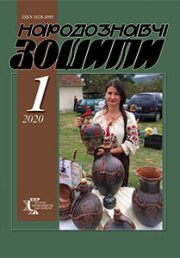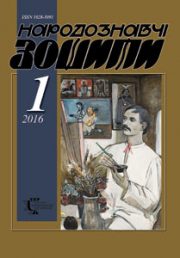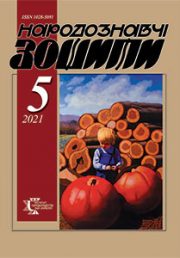The Ethnology Notebooks. 2023. № 6 (174), 1424—1429
UDK 398.341 : 391.985(477.41/.42)
DOI https://doi.org/10.15407/nz2023.06.1424
A RITUAL BUILDING TREE IN MINIATURE OF THE RADZIWILL CHRONICLE
SILETSKYI Roman
- ORCID ID: https://orcid.org/0000-0002-1451-5908
- Doctor of Historical Sciences, Professor, Ivan Franko Lviv
- National University, Department of Ethnology,
- 1 University Street, Lviv, 79000, Ukraine,
- Contacts: e-mail: r.sileckyi@gmail.com
Abstract. Annotation. The article is devoted to the analysis of the ethnological content of one of the miniatures of the Radziwill Chronicle — «The Foundation of the City of Belgorod» (990). The chronicle of the early thirteenth century was created in Volyn and is known from a copy of the fifteenth century. The miniatures illustrating the events described in the chronicle depict, among other things, numerous cultural and everyday realities of Ukraine-Rus’ in the twelfth and thirteenth centuries (primarily material culture phenomena: architecture and construction, production tools for builders, wheeled and sledged vehicles, clothing, musical instruments, tableware, etc.). They are a valuable, historically reliable visual source for ethnology. Expanding the source base of ethnology (especially visual sources related to the Middle Ages) is one of the urgent tasks of ethnological science. The introduction of such visual materials about various areas of folk culture into scientific circulation will contribute to a deeper study of its history. In particular, the reconstruction of the origin of the construction ritual tree, its evolution and transformation will be based on reliable source material and will help to increase the reliability of the conclusions. In addition, the study will help to increase the attention of ethnologists to the miniatures of the Radziwill Chronicle as a unique historical source for studying the traditional and everyday culture of the Ukrainian people.
The purpose of the proposed publication is to substantiate and prove that the Radziwill Chronicle’s miniature «The Foundation of the City of Belgorod» (990) depicts an attribute of traditional construction rituals: a ceremonial construction tree, the installation of which near the building preceded the start of construction. In addition, based on ethnographic materials of the nineteenth and early twenty-first centuries, an attempt is made to trace the evolution of this attribute of construction rituals in connection with the development of national construction (primarily housing), worldview and beliefs of Ukrainians. The object of the study is a miniature of the Radziwill Chronicle «The Foundation of the City of Belgorod» (990), which depicts the beginning of the construction of a new city. The subject of the study is to identify the ethnological content of this miniature, in particular, one of the attributes of the traditional construction rituals of Ukrainians — the ceremonial construction tree. To realize this goal, a number of research methods were used: historical and comparative, typological, comprehensive and retrospective analysis, historical reconstruction.
Keywords: chronicle, miniature, ethnology, Ukrainians, construction rituals, memorial customs and rites, beliefs, tradition.
Received 21.11.2023
REFERENCES
- Aseyev, Yu.S. (Ed.). (1989). Art of Kyiv Rus. Album. Kyiv: Art in Ukrainian].
- Dyba, Yu.R., Bokalo, I.Yu. (2016). Cities and defensive structures in miniatures of the Radzivyliv Chronicle. Current issues in research, conservation and restoration of historic fortification. Collection of scientific articles (Pp. 73—85). Chelm; Lviv [in Ukrainian].
- Arkhikhovsky, A.V. (1944). Old Russian miniatures as a historical source. Moscow: Moscow State University [in Russian].
- Glushko, M. (2003). Genesis of land transport in Ukraine (Cultural and historical problem). Lviv [in Ukrainian].
- Kukushkina, M.V. (Ed.). (1994). Radzivilov Chronicle: Text. Study. Description of miniatures (Book 1: Facsimile reproduction of the monument). St. Petersburg: Verb; Moscow: Art [in Russian].
- Afanasyev, A. (1868). Poetic views of the Slavs on nature: An experience of a comparative study of Slavic traditions and beliefs in connection with the mythological legends of other kindred peoples (Vol. II). Moscow [in Russian].
- Kraus, Fr.S. (1887). Das Bauopfer bei den Sudslaven. Mittheilungen der Anthropologischen in Wien (Vol. XVII, pp. 16—24) [in German].
- Zelenin, D.K. (2004). Tree totems in legends and rituals of European peoples. In Zelenin, D.K. Selected Works. Articles on spiritual culture. 1934—1954. (Traditional spiritual culture of the Slavs. From the history of the study) (Pp. 145—206). Moscow: Indrik [in Russian].
- Bystron J.S. (1917). Studies on folk customs. 1. Household establishments. Trials of the
- Academy of Skills. Faculty of History and Philosophy. Series I (Vol. XXXV, pp. 1). Krakow [in Polish].
- Baiburin, A.K. (1983). Dwelling in the rituals and ideas of the Eastern Slavs. Leningrad: Science. Leningrad branch [in Russian].
- Siletskyi, R. (2011). Traditional building rituals of Ukrainians: a monograph. Lviv: LNU named after Ivan Franko [in Ukrainian].
- Siletskyi, R. (2023). Wedding ceremony tree among Ukrainians: functions and mythological meaning. Ethnological Notebooks, 3, 511—524 [in Ukrainian].
- Kutelmah, K. (1997). Commemorative motifs in the Polish pike calendar ritual. Polissia of Ukraine: materials of historical and ethnographic research. Kyiv Polissia. 1994 (Vol. 1, pp. 172—203). Lviv: Institute of Folklore of the National Academy of Sciences of Ukraine [in Ukrainian].
- Galaichuk, V. (2021). Traditional demonological ideas of Ukrainians about household spirits: a monograph. Lviv [in Ukrainian].
- Shukhevich, V. (1899). Hutsulshchyna (Part 1). Materials for Ukrainian-Russian ethnology (Vol. II). Lviv [in Ukrainian].
- Radovych, R. (2015). Folk architecture of the Staro Sambir region of the 19th and first half of the 20th centuries. (Housing complex). Kyiv [in Ukrainian].
- Archive of the Institute of Ethnology of the National Academy of Sciences of Ukraine (hereinafter — the National Archives of the National Academy of Sciences of Ukraine). F. 1. Op. 2. Ref. 410a. Ark. 2—209 [in Ukrainian].
- Archive of National Academy of Sciences of Ukraine. F. 1. Op. 2. Ref. 444a. Ark. 37—68 [in Ukrainian].
- Archive of Ivan Franko National University of Lviv. F. 119. Op. 17. Case 206-E [in Ukrainian].
- Kosmina, T.V. (1980). Rural housing of Podillia. The end of the 19th and 20th centuries. Historical and ethnological research. Kyiv: Scientific opinion [in Ukrainian].
- Krymskiy, Ag. (1930). Zvynyhorod region. Shevchenko’s homeland in terms of ethnographic and dialectological household folklore texts (Part 1). Kyiv [in Ukrainian].






